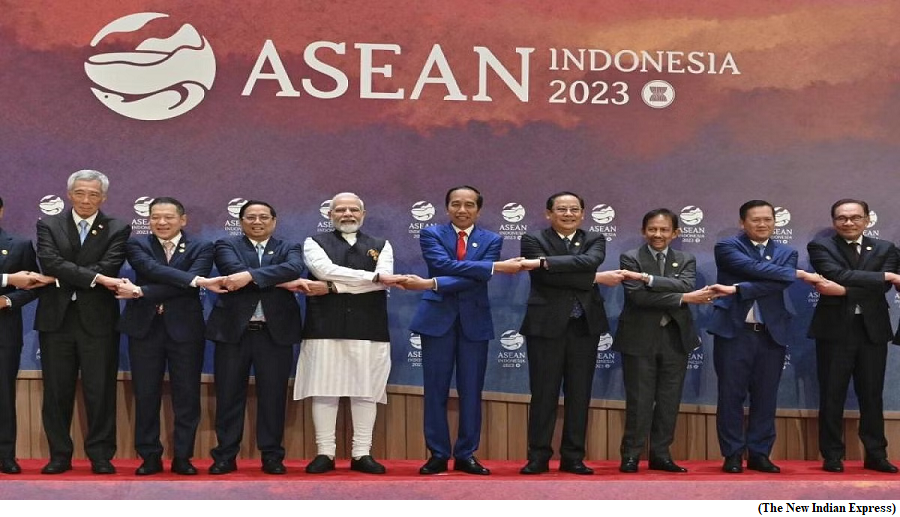Panchayats in Rajasthan to take up livelihood programmes in villages (GS Paper 2, Governance)

Why in news?
- The empowerment of Panchayati Raj Institutions in Rajasthan has enabled the village panchayats to take up livelihood programmes, in addition to their routine works for sanitation and creation of infrastructure.
- The three-tier Panchayati Raj structure in the State will also ensure an active participation of the public at large.
Mission Rajasthan-2030:
- The state government’s vision document would add diverse functions to village panchayats and enable them to play a meaningful role in the development of rural areas.
- The vision document forms part of ‘Mission Rajasthan-2030’ aiming to establish Rajasthan as the country’s top State by 2030.
Recommendations for vison document:
- Each village panchayat would be equipped to launch poverty alleviation programmes and take new initiatives for health, education, women’s security, children’s growth and environment protection.
- The panchayats will also assist the women’s self-help groups in their operations.
- A recommendation was made for linking women’s self-help groups with the private industries to enable their products to compete in the market on their own on the basis of their quality.
- Other suggestions received for the vision document pertained to rain water harvesting, development of pasture land in each village panchayat area, superimposing hydrology and meteorology data on the revenue maps, selection of specific industries for entrepreneurs in villages and connecting the rural livelihood programmes with nutrition and school uniforms.
Draft Guidelines for Prevention and Regulation of Dark Patterns
(GS Paper 3, Economy)
Why in news?
- The Department of Consumer Affairs has sought public comments on Draft Guidelines for Prevention and Regulation of Dark Patterns.

Objective:
- The objective of the Guidelines is to identify and regulate such practices which tend to manipulate or alter consumer choices, often by using deceptive or misleading techniques or manipulated user interfaces/web designs.
Details:
- The draft Guidelines for Prevention and Regulation of Dark Patterns have been framed after detailed deliberations with all stakeholders including e-commerce platforms, law firms, Government and Voluntary Consumer Organizations (VCO’s).
- Based on these deliberations and draft Guidelines submitted by the Task force to the Department of Consumer Affairs, present Draft Guidelines for prevention and regulation of dark patterns have been drafted and are now being put up for public consultation.
- Proposed Guidelines shall be issued under section 18 (2) (l) of the Consumer Protection Act 2019.
What is dark patterns?
The draft guidelines define dark patterns as
- any practices or deceptive design patterns using UI/UX (user interface/user experience) interactions on any platform;
- designed to mislead or trick users to do something they originally did not intend or want to do;
- by subverting or impairing the consumer autonomy, decision making or choice;
- amounting to misleading advertisement or unfair trade practice or violation of consumer rights.
Under the Guidelines, following Dark patterns have been specified:
- False Urgency means falsely stating or implying the sense of urgency or scarcity so as to mislead a user into making an immediate purchase or take an immediate action, which may lead to a purchase.
- Basket sneaking means inclusion of additional items such as products, services, payments to charity/donation at the time of checkout from a platform, without the consent of the user, such that the total amount payable by the user is more than the amount payable for the product(s) and/or service(s) chosen by the user.
- Confirm shaming means using a phrase, video, audio or any other means to create a sense of fear or shame or ridicule or guilt in the mind of the user, so as to nudge the user to act in a certain way that results in the user purchasing a product or service from the platform or continuing a subscription of a service.
- Forced action shall mean forcing a user into taking an action that would require the user to buy any additional good(s) or subscribe or sign up for an unrelated service, in order to buy or subscribe to the product/service originally intended by the user.
- Subscription trap means the process of making cancellation of a paid subscription impossible or a complex and lengthy process including similar other practices.
- Interface interference means a design element that manipulates the user interface in ways that (a) highlights certain specific information; and (b) obscures other relevant information relative to the other information; to misdirect a user from taking an action desired by her.
- Bait and switch means the practice of advertising a particular outcome based on the user’s action but deceptively serving an alternate outcome.
- Drip pricing means a practice whereby-elements of prices are not revealed upfront or are revealed surreptitiously within the user experience; and/or other such practices
- Disguised advertisement means a practice of posing, masking advertisements as other types of content such as user generated content or new articles or false advertisements.
- Nagging shall mean a dark pattern due to which users face an overload of requests, information, options, or interruptions; unrelated to the intended purchase of goods or services, which disrupts the intended transaction.
Way Forward:
- The proposed Guidelines seek to oversee such practices which are prejudicial to the consumer interests.
- The proposed guidelines will further strengthen the industry and protect consumer interests.
Modi presents a 12-point proposal to expand India-ASEAN relations
(GS Paper 2, International Organisation)
Why in news?
- Envisaging an expansion in cooperation between India and 10-nation ASEAN, Indian Prime Minister presented an extensive 12-point proposal at the 20th ASEAN-India Summit in Indonesia.
- From connectivity and trade to digital transformation, the roadmap encompassed a slew of diverse areas.

Connectivity:
- Indian Prime Minister unveiled an ambitious multi-modal connectivity initiative at the just-concluded 20th ASEAN-India Summit in Indonesia.
- The initiative aims to link Southeast Asia, India, West Asia and Europe, which experts suggest could be an alternative to China's One Belt, One Road programme.
About the 12-point proposal by PM Modi:
- Establishing multi-modal connectivity and economic corridor that links South-East Asia-India-West Asia-Europe.
- Offer to share India’s Digital Public Infrastructure Stack with ASEAN partners.
- ASEAN-India fund for Digital Future focusing on cooperation in digital transformation and financial connectivity.
- Renewal of support to Economic and Research Institute of ASEAN and East Asia (ERIA) to act as knowledge partner for enhancing engagement.
- Call for collectively raising issues being faced by Global South in multilateral for a.
- An invitation to ASEAN countries to join Global Centre for Traditional Medicine being established by WHO in India.
- Call for working together on Mission LiFE.
- Offer to share India’s experience in providing affordable and quality medicines to people through Jan-Aushadhi Kendras.
- A call for collective fight against terrorism, terror financing and cyber-disinformation.
- Invitation to ASEAN countries to join Coalition for Disaster Resilient Infrastructure.
- Call for cooperation in disaster management.
- Call for enhanced cooperation on maritime safety, security and domain awareness.
East Asia Summit:
- Also addressing the East Asia Summit, a forum in the Asia-Pacific region to deal with issues relating to security and defence, he called for joint efforts to strengthen sovereignty and territorial integrity of all nations.
- He said India believes a code of conduct for South China Sea should be effective and compliant with the UN Convention on the Law of the Sea (UNCLOS).
What is ASEAN?
- On 8 August 1967, five leaders; the Foreign Ministers of Indonesia, Malaysia, the Philippines, Singapore and Thailand came together in Bangkok.
- Over the next few decades, five other countries joined them – Brunei Darussalam, Lao PDR, Cambodia, Myanmar and Vietnam.
- They have an anthem, a flag and biannual summits (twice a year) with a rotating chairmanship. An example of the focus on unity, its official motto is “One Vision, One Identity, One Community”.
- The ASEAN Declaration signed by the five leaders conveyed the aspiration to further regional cooperation. These were about cooperation in the economic, social, cultural, technical, educational and other fields, and in the promotion of regional peace and stability and adherence to the principles of the United Nations Charter. It stipulated that the Association would be open for participation by all States in the Southeast Asian region subscribing to its aims, principles and purposes.
- Its major pillars that help lay out a blueprint for cooperation are Political-Security Community (APSC), Economic Community (AEC) and Socio-Cultural Community (ASCC).
What is India’s link with ASEAN?
- ASEAN (Association of Southeast Asian Nations) is the “central pillar” of India’s Act East Policy and the country fully supports the group’s centrality and outlook on the Indo-Pacific.
- India is part of the ASEAN Plus Six grouping, which includes China, Japan, South Korea, New Zealand and Australia as well.
- In 2010, a Free Trade Agreement was also signed and entered into force between India and ASEAN.
- While India was part of negotiations to join the Regional Comprehensive Economic Partnership (RCEP) in 2020, it ultimately decided not to do so. However, in the past eight years, trade has grown in terms of value, barring the pandemic years of 2020 and 2021.
- ASEAN itself has recently faced issues that complicate coordination, such as the rise of China and its claims over the South China Sea (many of which compete with claims of ASEAN members like the Philippines) and the issue of military conflict in Myanmar.




